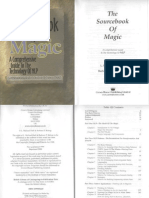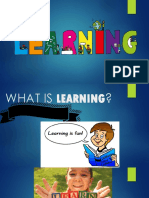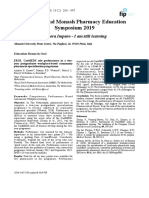100% (2) 100% found this document useful (2 votes) 2K views 438 pages Dynamic Learning
Dynamic Learning offers stimulating step-by-step procedures that help you to make better use of the most valuable resource you have- your brain. This book applies the process of learning through experience. The techniques and exercises in this book involve learning by doing and by exploring different strategies to learn. These methods can be used by children or adults, anyone who wants to improve his or her abilities to learn, and have been especially effective for people who have experienced difficulty in learning. Topics covered include: remembering people's names, strengthening your senses and mental capabilities to improve in every type of learning, improving memory, reading faster and with better comprehension, spelling more easily and accurately, learning foreign languages more quickly and writing more creatively and fluently. Highly recommeded.
Copyright
© © All Rights Reserved
We take content rights seriously. If you suspect this is your content,
claim it here .
Available Formats
Download as PDF or read online on Scribd
Go to previous items Go to next items
Save Dynamic learning For Later baPning’
HAR US
Jon AY EASte�‘exercises and step-by-step procedures that help you to make
better use of the most valuable resource you have—your brain.
‘The authors describe a muliitude of ways to make learning. fun,
public seminars, and consulting and training in the public
‘school system.
Dynamic Learning apples the process of learning though
adults and have been especially effective for people who have
‘experienced dificulties in learning.
‘This book provides effective stratogice and methods to:
‘Dynamic Learning provides a wealth of information and activities
‘that can be used by anyone who wants to improve his or her
abilities to learn, Discover the methods that transformed an
entire school district and have changed the lives of many people
Who thought they were “slow,” *stupid;" oF incapable ofleaming,�Dynamic
Learning
by
Robert B. Dilts
and
Todd A. Epstein�Meta Publications
P.O, Box 1910
Capitola, California 95010
(831) 464-0254
FAX (831) 464-0517
© Copyright 1995 by Meta Publications. Printed in the United States
of America. All rights reserved. This book or parts thereof may not
be reproduced in any form without written permission of the Publisher.
Library of Congress Card Number 95-078653
IS.BN. 0-916990-37-X.�Contents
Dedication
Acknowledgments
Preface
Introduction
Cuapren 1 Foypamentats o Dynamic L2annine
Levels of Learning
‘The Influence of Relationships on Learning
Cooperative Learning
Neuro-Linguistic Programming
Balancing Task and Relationship
The R.O.L.E. Model
‘The B. A. G. ELL, Model
Identifying an Effective Learning State
Cuapter 2 REMEMBERING NAMES
Name Tag Exercise
Eliciting Name Remembering Strategies
Summary of Effective Strategies for
Remembering Names
Cuapren 3 Memory Strarecies
Memory Strategy Worksheet
‘Memory Strategy Progress Report
Visual Memory Exercise
Auditory Memory Exercise
Kinesthetic Memory Exercise
Long Term and Short Term Memory Strategies
iti
vii
xiii
10
13
16
18
22
27
33
37
38
40
52
87
59
61
62
81
89
93�(Cuaprer 4 STRENGTHENING THE SENSES
Developing Visual Skill
Developing Auditory Skill
Developing Kinesthetic Skill
‘Summary: Strategies for Developing the Senses
Exploring Perceptual Filters
(Cuaprer § Cooperative Learninc an THE T.O.T-E.
‘Telephone’ Strategy Game
Self Organization and ‘Attractors’
The T.O.T.E. Model
Exploring the Structure of a Learning Strategy
Feedback and Cooperative Learning
Cooperative Learning Exercise
Cuaprer 6 SPELLING
‘Modeling Spelling Strategies
Patterns of Effective Spelling
Stratogies for Learning New Words
‘The Spelling Strategy
Applying The Spelling Strategy
Using The Spelling Strategy with
Children Who Have Learning Problems
Practicing The Spelling Strategy
‘Teaching The Spelling Strategy in the Classroom
Cuaprer 7 Lanauace Leannine
Learning Language
Modeling Effective Language Learning
‘Second Position’ Modeling
Developing Vocabulary
Objects and Actions
Adverbs and Adjectives
Obstacle Course
‘Nominalizations, Abstractions and Unspecified Verbs
Idioms
Simple Syntax
Role Playing
97
102
107
118
123
130
195
136
141
142
145
148
155
157
160
170
174
184
189
195
204
210
213
212
220
225
231
237
243
248
250
252
254
258�(Cuarren 8 Reapixa
Reading Comprehension
Speed Reading Strategies
Reading and the T.0.1.E.
Accelerated Reading
Calibrating Your Natural Reading Speed
Expanding Your Vision to See Word Clusters
Choosing an Appropriate Eye Scanning Pattern
Reducing Sub-Vocalization and
Internal Pronunciation
Developing a Visual Comprehension Strategy
Going Through a Preorganization Strategy
Finding Your Optimal Physiological State for Reading
Recalibrating Your New Natural Reading Speed
Cuaprer 9 Creative Warrinc
Connectives
Preparing to Write
Determining Your Audience
Creating Prompts
Interactive Writing
Cuarrer 10. Drnamic Assessoent
The Dynamic Assessment Process
Dealing with Resistances and Interferences
to Learning
Conclusion
Cuaprer 11 Qpncusion
AFTERWORD
Appenprc A Leveis oF LeaRNinc
Aprenpix B Summary or Learnina Sratectes
Identifying an Effective Learning State
Remembering Names
Memory Strategy Exercises
Devloping Visual Skill
Developing Auditory Skill
257
258
265
270
217
278
280
283
284
287
288
291
203
296
300
305
308
312
325
328
337
344
345
349
351
355
355
358
360
366
367�Developing Kinesthetic Skill
Exploring Perceptual Filters
‘Telephone’ Strategy Game
Exploring the Structure of a Learning Strategy
Cooperative Learning Exercise
Spelling Strategy
Basic Spelling Strategy (Short Version)
Basic Language Learning Strategies
Accelerated Reading Strategy
Speed Scanning Strategy
Creative Writing Strategy
Appenpix C RESEARCH ON THE SPELLING STRATEGY
Appenpmx D Maru Strarecy
Appenpix E Tur WRITING Cuses PRocRam
Appenpix F Typine SrraTEcy
Appenpnx G Tar NevRoLinx
‘BrsiocRaPHY
368
370
a7
376
379
380
383
385
390
396
399
409
415
417
419
423
425�Dedication
‘This book is dedicated with deepest love and respect to
Todd Epstein
the embodiment of Dynamic Learning.
vii�Acknowledgments
‘We would like to acknowledge:
Teresa Epstein, Todd's wife and our colleague in the develop-
‘ment and evolution of the Dynamic Learning Center. She has been
and continues to be an invaluable part of carrying out the mission
of Dynamic Learning.
Christine Amato, who has shared our vision and mission in the
area of education and learning, and who opened the doors for
Dynamic Learning in the school system.
‘The Pajaro Valley School District, for sponsoring the Dynamic
Assessment project. And Richard Figuroa the State of California,
for providing the impetus and the backing for the project.
Jeannie Higano, who sponsored the first Dynamic Learning
seminar and coined the term.
John Grinder and Richard Bandler, who founded the technology
upon which Dynamic Learning is based and taught us the true
meaning of ‘dynamic learning’.
‘Ami Sattinger, for her help with the editing and proof reading of
the manuscripts for this book and for her enthusiasm and support
for this project.
The students and teachers who participated in our Dynamic
Learning seminars and the Dynamic Assessment project.
‘And many thanks to the exceptional individuals who served as
the models for the learning strategies presented in this book.
ix�Preface
In June of 1982 I conducted the first Dynamic Learning seminar
in Vancouver, British Columbia. It was a five-day program made
up of learning strategies that I had modeled from my studies of
people who had demonstrated academic excellence in subjects such
as memory, spelling, math, reading, language learning and cre-
ative writing. Over half of the participants of the sominar wero
school aged children. I had put together the program because I had
received so many requests to work with people of various ages in
that area who were having learning problems. The seminar also
included tho uso of interactive computer programs that I had
designed to teach spelling, math, typing, composition, and the
development of certain perceptual skills.
‘The purpose of the Dynamic Learning seminar was to provide a
set of basic learning skills in an experiential, interactive environ-
ment that would help people improve in all areas of academic
performance. In other words, it was a seminar about ‘learning to
learn’. The mornings were for explanations and demonstrations of
the various learning strategies and exercises. In the afternoons,
the participants practiced these activities while I worked one-on-
one with students who were having specific learning problems. The
program was quite successful and seemed to me to be an innova-
tive form of teaching and learning. I repeated the program several
more times in British Columbia, tightening up the strategies and
the structure.
In October of 1982, I co-presented a Dynamic Learning seminar
in Palo Alto, California with Todd Epstein—it was the beginning of
a partnership that was to last for the next thirteen years. Todd had
been a colleague of mine for several years prior to this and we had
conducted a number of NLP trainings together. Todd had been a
professional guitar player, composer and band leader before get-
ting involved in the field of NLP, so he had a natural zeal for
creativity and performance; but he also had an intense passion for
learning. When I had explained to him what I was doing in
‘Vancouver, he had become very excited about the Dynamic Learn-
ing concept. It appealed to his innate curiosity, love for experi
xi






































































